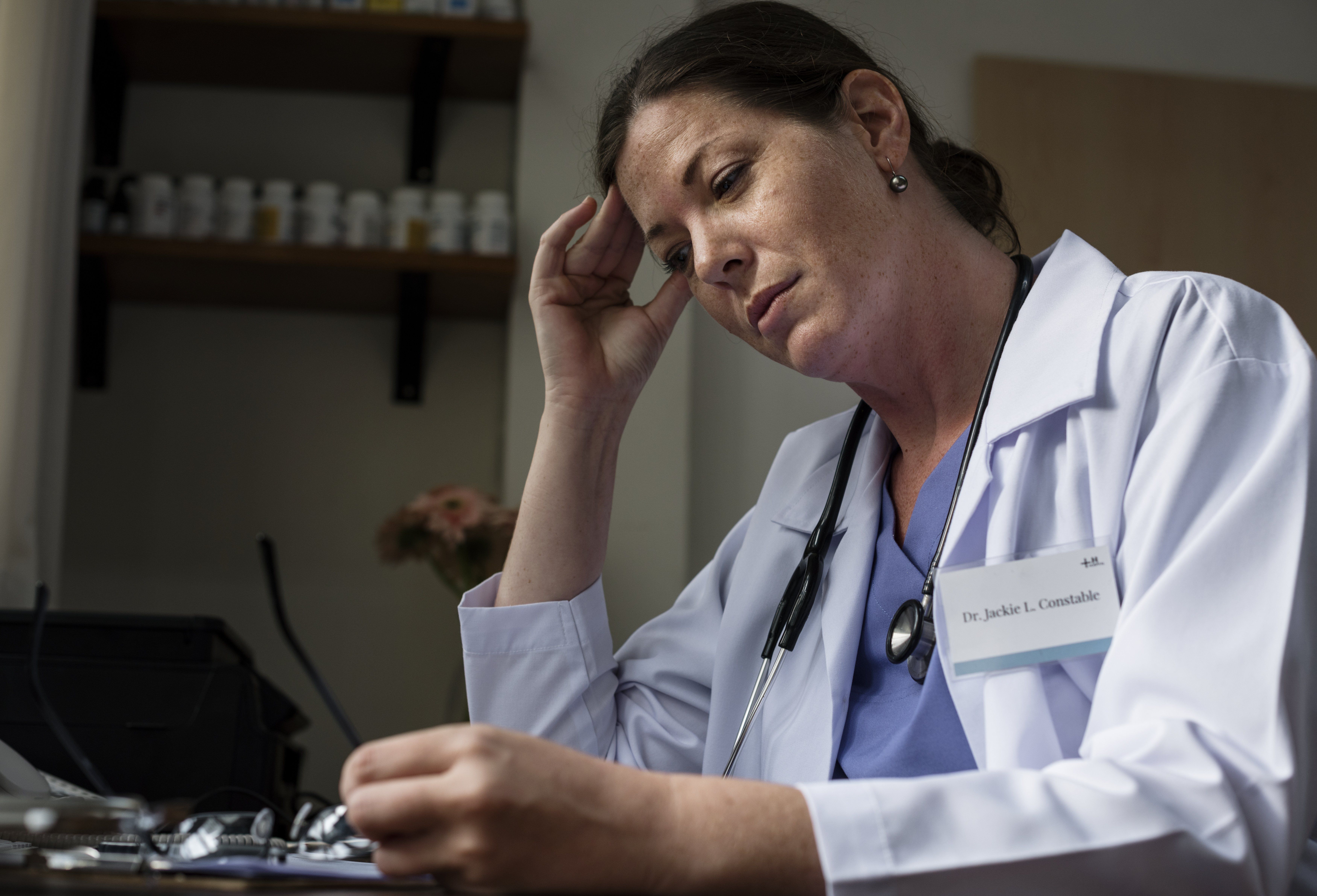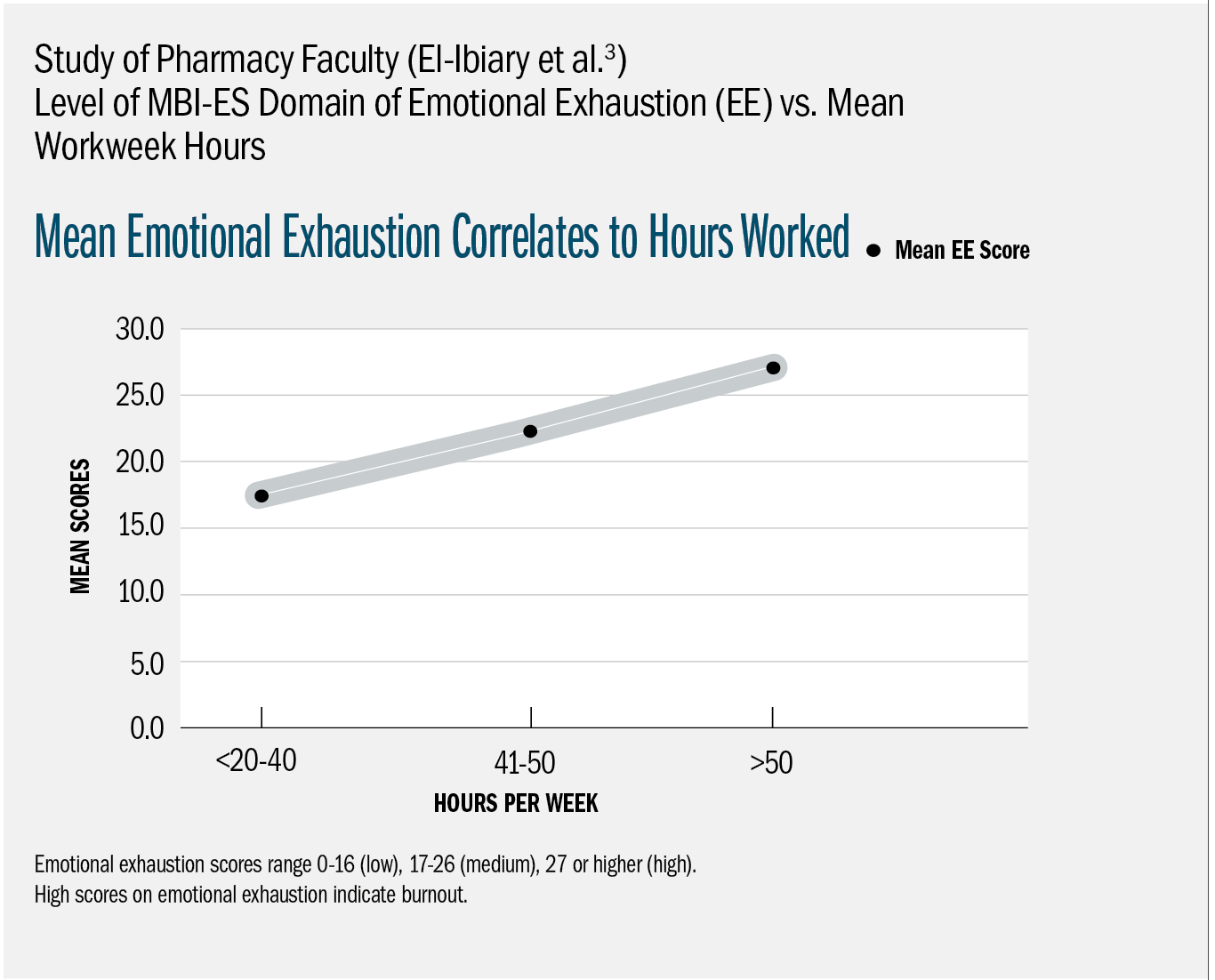Avoiding Pharmacist Burnout
Professional associations, gratitude can keep you engaged, healthy

Mean Emotional Exhaustion Correlates to Hours Worked

A recent study in the American Journal of Health-System Pharmacy reported that more than half of health-system pharmacists have a high-degree of burnout. Healthcare experts say all involved in the pharmacy industry-including student pharmacists and pharmacy residents-are also at risk of burnout in their careers.
The study revealed that 53.2% of health-system pharmacists reported scores indicating a high degree of burnout on at least one subscale of the Maslach Burnout Inventory-Human Services Survey (MBI-HSS). This is similar to published burnout rates for physicians and nurses.1
Shareen El-Ibiary, PharmD, BCPS, FCCP, professor and chair of the Department of Pharmacy Practice, Midwestern University College of Pharmacy-Glendale, was involved in a study that looked at burnout rates among pharmacy practice faculty. That study revealed that 41% were experiencing high levels of emotional exhaustion, one dimension of burnout.2
Additionally, a 2017 study among clinical pharmacists also showed high levels of emotional exhaustion (61%).3
“We found that many faculty work longer hours, and those that worked 50 hours or more per week had higher levels of emotional exhaustion,” she says. “We also found that women, junior faculty, those with young children (1 to 12 years old), those without a mentor, and those without a hobby had higher levels of emotional exhaustion.”
Why So Much Burnout?
Christina Martin, PharmD, director of membership forums with the ASHP, says burnout is associated with compromised patient safety and a loss of productivity in the workforce.
“Stress and burnout can be caused by individual factors, external factors, or a combination,” she says. “Individual factors can include personal factors, such as family dynamics, sense of purpose, or personal financial stressors.” External factors, which the research suggests carry more weight in contributing to burnout, can include maintenance of license and certification, increased rules and regulations, workload, high employee turnover, and drug shortages.
Erin Albert, PharmD, senior director for education for the American Society of Consultant Pharmacists, says some of the reasons for burnout in pharmacy are pressure to perform at better and faster rates, needing to do more with fewer resources and time, and increased competition in the workplace with more pharmacy schools producing more pharmacists.
“It’s not a new problem, but it’s a problem that has increased over time and accelerated due to increased competition, decreased margins on traditional prescription filling and metric constraints,” she says.
“We see it in all areas of practice too, even areas where there is a (false) perception that pharmacy jobs are ‘easier’ than retail or hospital, such as pharmacy academia,” she adds.
A systematic review on burnout across industries found that problems like cardiovascular diseases, pain, depression, job dissatisfaction and higher absenteeism in the workplace are all effects of burnout.4
“Burnout literally changes our brains,” Albert says. “That’s why it is so important for self-care with healthcare professionals.”
Maria Marzella Mantione, PharmD, CGP, FAPhA, an associate clinical professor at St. John’s University College of Pharmacy and Health Sciences in New York, says the problem is prevalent.
“The list of responsibilities keep growing, but the resources, even with technology and all the efficiency we have available, keeps narrowing,” she says.
“I think the burnout is due to how much pharmacists care. They have little autonomy over how they spend their time, and want to be doing what they can, what they are trained for, and to follow their purpose; but the pressure on them to do things their management expects, how their management expects, without being heard as to how [they] think it would be best to do, leads to a cycle of frustration.”
Sonia Martinez, RPh, pharmacist-in-charge at Marco Drugs and Compounding in Miami, says exhaustion among pharmacists is widespread and believes it’s even more pervasive among independent pharmacist-owners, due to lower reimbursements and increased regulations.
“Pharmacy practice can feel repetitive, and, candidly, many tasks could be tedious,” she says. “As a pharmacist, we are required to juggle many responsibilities almost simultaneously like filling and verifying the accuracy of scripts, answering the phones and questions from insurances, providers or patients. We are also required to fulfill several administrative and or regulatory tasks with little real clinical meaning, adding to the workload burden.”
Moreover, in these times of low reimbursements adding additional help-more pharmacists or pharmacy techs-may not be financially sustainable.
Recognizing the Signs
It’s important that people in the field do not ignore the signs of burnout and pay attention to the people they work with. When a colleague snaps back at coworkers or even customers, that’s a telling sign. Albert believes the best way to recognize early signs of burnout both in yourself or in your staff, is by self-monitoring.
“I personally do self-monitoring a la the ‘Sunday night effect.’ On Sunday night, are you totally excited that you’re headed back to work on Monday morning, or are you dreading it? Dread over time shows a pattern of burnout,” she shares. “Anger can be an early warning sign, and apathy typically shows up later. If an employee hits apathy, it might be too late.”
Martinez says pharmacists should check for warning signs in themselves, such as whether they are cynical in one’s comments and thoughts or perceive that there is no progress in their career.
“When one sees that their own state is more pessimistic than usual,” she says. “But this requires a lot of personal knowledge and awareness.”
Mantione says a simple way to check is to ask. “Taking some time to reflect after a busy day could make a bit of a difference,” she says. “Management can check in on staff and listen when they say that they need more help getting everything done.”
She adds that most pharmacists went into the profession because of that desire to help, but find it harder and harder to do that with the resources they have. “We pride ourselves as a profession on being accessible, but that accessibility makes us feel as though we are being pulled in many different directions,” she says. “We need breaks, time to rest, time to eat, and use the restroom, etc. We have situations where pharmacists are going into work sick because they feel so responsible. They can’t take breaks sometimes even when given them because they know the work will just pile up while they are gone and the situation will get worse. In so many instances, it is simply unmanageable.”
Tips to Reduce Burnout
When it comes to burnout, every pharmacist is dealing with their own personal struggles, so solutions will be different from person to person. The best advice is to find the positive differences that one makes each day and hold onto them, and try your best to let the frustrations go.
Mantione has turned to social media for help. She belongs to a group on Facebook called Pharmacist Moms that provides a platform for women in the field to share ideas, exchange information and support each other.
“Having that kind of tribe can go a long way to improving your mental health and managing stress,” she says.
One helpful trick that Martinez learned from Mark Robert Waldman, neuroscience researcher at Loyola Marymount University, is to yawn purposefully every hour or so. “Based on his research, this gives our brain a break. I call it a mental reboot,” she says. “I also do a daily meditation practice, and that’s what keeps me sane.”
The No. 1 piece of advice from many is that it’s absolutely critical for those in the industry to use every last bit of vacation. “If you don’t use your vacation, you’re leaving something more precious than money on the table. You’re leaving time behind, and time is something you never, ever get back,” Albert says.
She also recommends channeling negative energy into something positive. For those who have a boss, she also recommends discussing concerns and trying to alter responsibilities to more of the work one enjoys.
“I also think it’s a good idea to join associations and groups, and find a mentor,” Albert says. “You need a sounding board for your career. Learn from others. Attend association events and experiences that get you out of your day-to-day office environment and provide you a list of ideas and other ways of working.”
And not all your time needs to be spent doing things that are pharmacy-specific. Sometimes it’s good to get out of one’s comfort zone to reduce burnout. For example, in November, Albert attended the 39th Edition of the Toronto International Festival of Authors and attended a lecture by two historians about Canadian WWII war heroes.
“I was absolutely fascinated by the experience of attending this festival, in another country outside of my own,” she says. “I retained more cool ideas from attending that one-hour session than I have sitting in my office grinding out my work in the past two weeks.”
ASHP’s policy statement on clinician well-being and resilience states that workforce well-being and resilience requires a shared responsibility between individuals and organizations.
“Individuals need to identify and bolster their own resiliency and coping skills and organizations need to meaningfully promote well-being and lead system-level changes to address the external factors contributing to burnout,” Martin says.
“On the individual side, mindfulness and meditation have shown promising and validated improvements; however, this approach doesn’t resonate with everyone,” she adds.
One specific technique has been identified as a means to increase positivity in the minds of a healthcare worker. It is the “three good things” approach. You write down three good things that happened that day for 21 consecutive days until the practice becomes a habit.
Help Is Needed
Once burnout has occurred, it is difficult to recover. Still, reducing pharmacist burnout isn’t impossible. Martin says there is much that can be done.
ASHP offers a member-only resource center devoted to the topic and offer several webinars on a variety of topics ranging from mindfulness and meditation to leadership strategies.
The National Academy of Medicine has an Action Collaborative to promote clinician and healthcare provider well-being and resilience. Another program is one by the American Medical Association that promotes resiliency, called STEPS Forward. It is designed for physicians and medical students, but many of the concepts can also apply to pharmacists.
“Commitment to addressing and preventing burnout needs to be adopted by everyone from the top level executive to the front line clinician,” Martin says.
References
- Durham ME, Bush PW, Ball AM. Evidence of burnout in health-system pharmacists. Am J Health Syst Pharm. 2018 Dec 1;75(23 Supplement 4):S93-S100; 2018. doi: 10.2146/ajhp170818. Epub 2018 Oct 17.
- Salvagioni D et al. (2017). Physical, psychological and occupational consequences of job burnout: A systematic review of prospective studies. PloS One, 12(10), e0185781. doi:10.1371/journal.pone.0185781
- El-Ibiary SY, Yam L, Lee KC. Assessment of burnout and associated risk factors among pharmacy practice faculty in the United States. Am J Pharm Educ, 81(4): 75; 2017.
- Jones GM et al. Factors associated with burnout among US hospital clinical pharmacy practitioners: Results of a nationwide pilot survey. Hosp Pharm. 52(11): 742-751; 2017.
